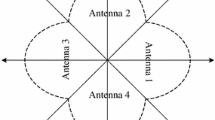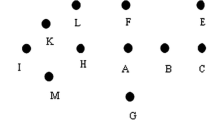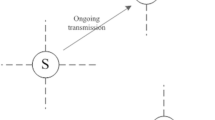Abstract
Using directional antennas in ad hoc networks may introduce the well-known deafness problem, exacerbate the hidden terminal problem and the exposed terminal problem, add difficulty on mobile communication, and distort the operation of existing routing and TCP protocols. Although a lot of studies have been undertaken on the directional MAC protocols, most of them focus only on one or several aspects in their design and performance evaluations, and a comprehensive comparative study is missing. In this paper, we first explore the design space of directional MAC and present a taxonomy of existing schemes. Then, we discuss the major problems in using directional antennas under different category of MAC schemes. After that, we propose coordinated directional medium access control (CDMAC), a novel directional MAC protocol to improve throughput via facilitating the simultaneous contention-free communications for multiple local node-pairs. We evaluate our CDMAC, one representative existing scheme and IEEE 802.11 via extensive ns2 simulations. Our results show CDMAC provides a satisfactory solution to all the major problems and significantly improves the throughput performance.













Similar content being viewed by others
Notes
A node-pair consists of an intended data sender and an intended data receiver with certain data-transmission direction.
References
IEEE standard for wireless LAN medium access control (MAC) and physical layer (PHY) specifications, ISO/IEC 8802-11: 1999(E), August 1999.
Rappaport, T. (2002). Wireless communications principles and practice. Prentice Hall.
Zhang, Z., Iskander, M. F., Yun, Z., & Madsen, A. H. (2003). Hybrid smart antenn system using directional elements—performance analysis in flat Rayleigh fading. IEEE Transactions on Antennas and Propagation, 51(10).
Ko, Y. B., Shankarkumar, V., & Vaidya, N. H. (2000). Medium access control protocols using directional antennas in ad hoc networks. In Proceedings of IEEE INFOCOM.
Nasipuri, A., Ye, S., You, J., & Hiromoto, R. E. (2000). A MAC protocol for mobile ad hoc networks using directional antennas. In Proceedings of the WCNC.
Ramanathan, R. (2000). On the performance of ad hoc networks with beamforming antennas. In Proceedings of the ACM MobiHoc, Long Beach, CA.
Takai, M., Martin, J., Ren, A., & Bagrodia, R. (2002). Directional virtual carrier sensing for directional antennas in mobile ad hoc networks. In Proceedings of ACM MOBIHOC, Lausanne, Switzerland.
Choudhury, R. R., Yang, X., Ramanathan, R., & Vaidya, N. (2002). Using directional antennas for medium access control in ad hoc networks. In Proceedings of ACM MOBICOM, Atlanta, Georgia.
Korakis, T., Jakllari, G., & Tassiulas, L. (2003). A MAC protocol for full exploitation of directional antennas in ad-hoc wireless networks. In Proceedings of ACM Mobihoc, Annapolis, Maryland.
Gossain, H., Cordeiro, C. M., Cavalcanti, D., & Agrawal, D. P. (2005). MDA: An efficient directional MAC scheme for wireless ad hoc networks. In Proceedings of IEEE GLOBECOM, St. Louis, Missouri, USA.
Choudhury, R. R., & Vaidya, N. (2004). Deafness: A MAC problem in ad hoc networks when using directional antennas. In Proceedings of IEEE ICNP, Berlin.
Fahmy, N. S., & Todd, T. D. (2004). A selective CSMA protocol with cooperative nulling for ad hoc networks with smart antennas. In Proceedings. of IEEE WCNC, Atlanta.
Singh, H., & Singh, S. (2004). Tone based MAC protocol for use with adaptive array antennas. In Proceedings of IEEE WCNC, Atlanta.
Sundaresan, K., & Sivakumar, R. (2004). A unified MAC layer framework for ad hoc networks with smart antennas. In Proceedings of ACM MobiHoc, Roppongi, Japan.
Ramanathan, R., Redi, J., Santivanez, C., Wiggins, D., & Polit, S. (2005). Ad hoc networking with directional antennas: A complete system solution. Journal of Selected Areas in Communications.
Muqattash, A., & Krunz, M. (2004). A single-channel solution for transmission power control in wireless ad hoc networks. In Proceedings of MobiHoc, Tokyo, Japan.
Acharya, A., Misra, A., & Bansal, S. (2003). MACA-P : A MAC for concurrent transmissions in multi-hop wireless networks. In Proceedings of the first IEEE PerCom 2003 conference, pp. 505–508.
Sadeghi, B., Kanodia, V., Sabharwal, A., & Knightly, E. (2002). Opportunistic media access for multirate ad hoc networks. In Proceedings of MOBICOM.
Zhu, H., & Cao, G. (2005). rDCF: A relay-enabled medium access control protocol for wireless ad hoc networks. In Proceedings of IEEE INFOCOM.
Wang, J., Zhai, H., & Fang, Y. (2004). Opportunistic packet scheduling and media access control for wireless LANs and multi-hop ad hoc networks. In Proceedings of IEEE WCNC, Atlanta.
Santivanez, C., & Redi, J. (2003). On the use of directional antennas for sensor networks. In Proceedings of IEEE MILCOM, Boston.
Lu, K., Wang, J., Wu, D., & Fang, Y. (2006). Performance of a burst-frame-based CSMA/CA protocol for high data rate ultra-wideband networks: Analysis and enhancement. In Proceedings of the Third International Conference on Quality of Service in Heterogeneous Wired/Wireless Networks, Waterloo, Ontario, Canada.
Kushner, H., & Yin, G. (1997). Stochastic approximation algorithms and applications. New York: Springer-Verlag.
Acknowledgements
This work was supported in part by the U.S. National Science Foundation under grants CNS-0721744 and DBI-0529012. The work of Fang was also supported in part by the National Science Council (NSC), R.O.C., under the NSC Visiting Professorship with contract number NSC-96-2811-E-002-010 and Chunghwa Telecom M-Taiwan Program M-Taoyuan Project.
Author information
Authors and Affiliations
Corresponding author
Rights and permissions
About this article
Cite this article
Wang, J., Zhai, H., Li, P. et al. Directional medium access control for ad hoc networks. Wireless Netw 15, 1059–1073 (2009). https://doi.org/10.1007/s11276-008-0102-9
Published:
Issue Date:
DOI: https://doi.org/10.1007/s11276-008-0102-9




